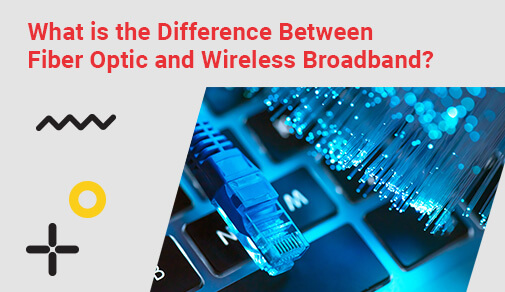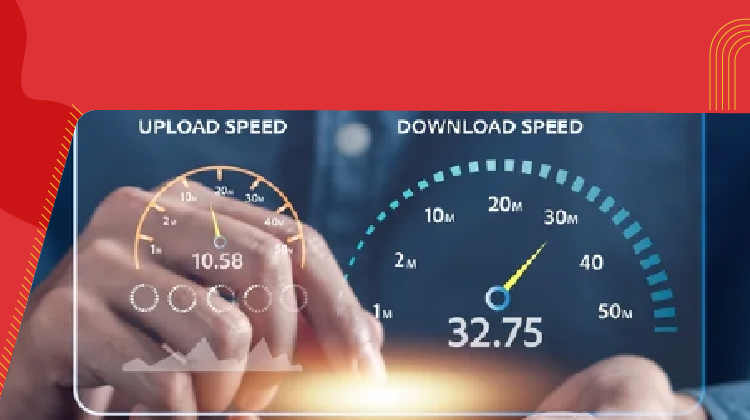Difference between Fiber optic and wireless broadband
Wednesday, Sep 29, 2021 · 4 minutes


WIRELESS
Wednesday, Sep 29, 2021 · 4 minutes
There are more than 5 billion internet users on the earth in 2021, and the total population of our human civilization is reaching 8 billion. As you finish reading this blog, more than 500 new people will have their very first experience with the Internet. It seems impossible to exist outside this multiverse.
When it comes to getting a new connection, you are left with two options. The first one is fiber optic, and the second is wireless broadband. Today we are going to show you the advantages and disadvantages of both, so you can make an informed decision. So let's get started, shall we?
Let's first discuss the elephant in the room: the fiber optic connection. If you are interested in learning about fiber optics, we've simplified it for you. A fiber optic is a method of providing internet connection through pulses of light via strands of fiber that are made up of glass or, in some cases, plastic. It might come as a surprise to you, but the fiber optic diameter is equal to the strand of human hair.
This has 2 fiberglass cables with a diameter of 8.4 to 10 microns which comes with one mode of transmission. The single-mode is much narrower, from which only one mode can propagate. It has a higher carrier bandwidth in comparison to the multimode fiber.
This one has got a bit more diameter, and 2 fiber cables are used here. Multimode has a higher bandwidth speed for the medium range. On the other hand, due to multiple paths of light, the signal can experience distortion. Thus, multimode isn't recommended for long-distance connections.
The world is slowly shifting to fiber-optic connection, but still, the power of wireless broadband has a stronghold. One of the biggest advantages of a wireless broadband connection is that it can be ready in just a few days and used as soon as groundworks are finished. There are tons of permits with fiber optic, and digging work needs to be done before the actual process. So wireless broadband is still one of the fastest ways to connect to the Internet, even in remote areas.
In addition to this, the speed of the Internet in wireless broadband services is almost equal to that of optic cable, but with less hassle. A mid-size tech company can easily manage all the network requirements with a 50 Mbps to 500 Mbps connection, which can be easily transmitted with a broadband connection.
Below is a side-by-side comparison of the two technologies, so it is easier for you to understand which one is a better option for you.
| Fiber Optic | Wireless Broadband Connection |
|---|---|
| The Fibre-optic connection is built around the fiber optics, which uses light to transmit the data. | The Wireless broadband connection works by converting the data packets into electromagnetic waves to broadcast them on a specific channel. |
| Fiber optic provides the same speed, but the way fiber optic handles the network congestion and provides high speed makes it a better option when a single network is handling many users. | With a wireless connection, you will face network congestion that causes slow load times. |
| Fiber optic connection's speed and network stability don't degrade proportionally with distance. | The distance can sometimes hamper the speed of your network when you are working with a wireless connection. |
| Fiber optic cables have been installed in urban and metro cities. But if you are living in the countryside, it will take some time or even years for you to get a reliable connection. | On the other hand, a wireless connection theoretically can be installed anywhere in the world. |
| The cost of laying down a fiber optic is quite expensive, and it could take months before you could make a connection with the Internet. | One of the biggest advantages of a wireless connection is that it is cost-effective in many ways. Wireless broadband services can even provide internet connectivity in the remotest areas. |
| If a fiber optic is broken, the cost of replacing that part can be quite high. | The installation process is quite easy, and within a day or two of applying, you will get it installed in your office or home. |
| Lastly, the fiber optic connection works with a specific set of hardware, and that also comes at a cost that some people might not be comfortable investing in. | No need to buy expensive hardware to get connected to the internet. A wireless connection works with all network hardware, no matter what they cost. |
Wrapping up
So, these were some of the major differences between a fiber-optic connection and a wireless broadband connection. When you are deciding to choose the right network connection, it would help if you weighed the benefits and the disadvantages to see which one is a better option for you.
If you are living in a remote area, then instead of waiting for the fiber connection to come, you must go with ACT Fibernet’s wireless connection. It is a much better option in several ways and provides connectivity even when you are living in the countryside. Apart from this, if you have the budget and live in urban areas where the groundwork has already been done, then a fiber-optic connection is the one for you.
101

The New Social: How High-Speed Internet is Redefining 'Quality Time' with Friends and Family
Read more396

How ACT SmartWi-Fi is Redefining Home Internet in 2025: The Age of AI-Powered Seamless Connectivity
Read more154

From Bandwidth to Intelligence: How AI Is Redefining Business Demands from ISPs
Read more
A referral link has been sent to your friend.
Once your friend completes their installation, you'll receive a notification about a 25% discount on your next bill
![]() Please wait while we redirect you
Please wait while we redirect you

![]() One of our representatives will reach out to you shortly
One of our representatives will reach out to you shortly

One of our representatives will reach out to your shortly
![]() Please wait while we redirect you
Please wait while we redirect you

Please enter your registered phone number to proceed

Please enter correct OTP to proceed


Dear customer you are successfully subscribed
Please wait while we redirect you

Your ACT Shield subscription has been successfully deactivated

Dear user, Your account doesn't have an active subscription

Dear customer Entertainment pack is already activated.
Please wait while we redirect you